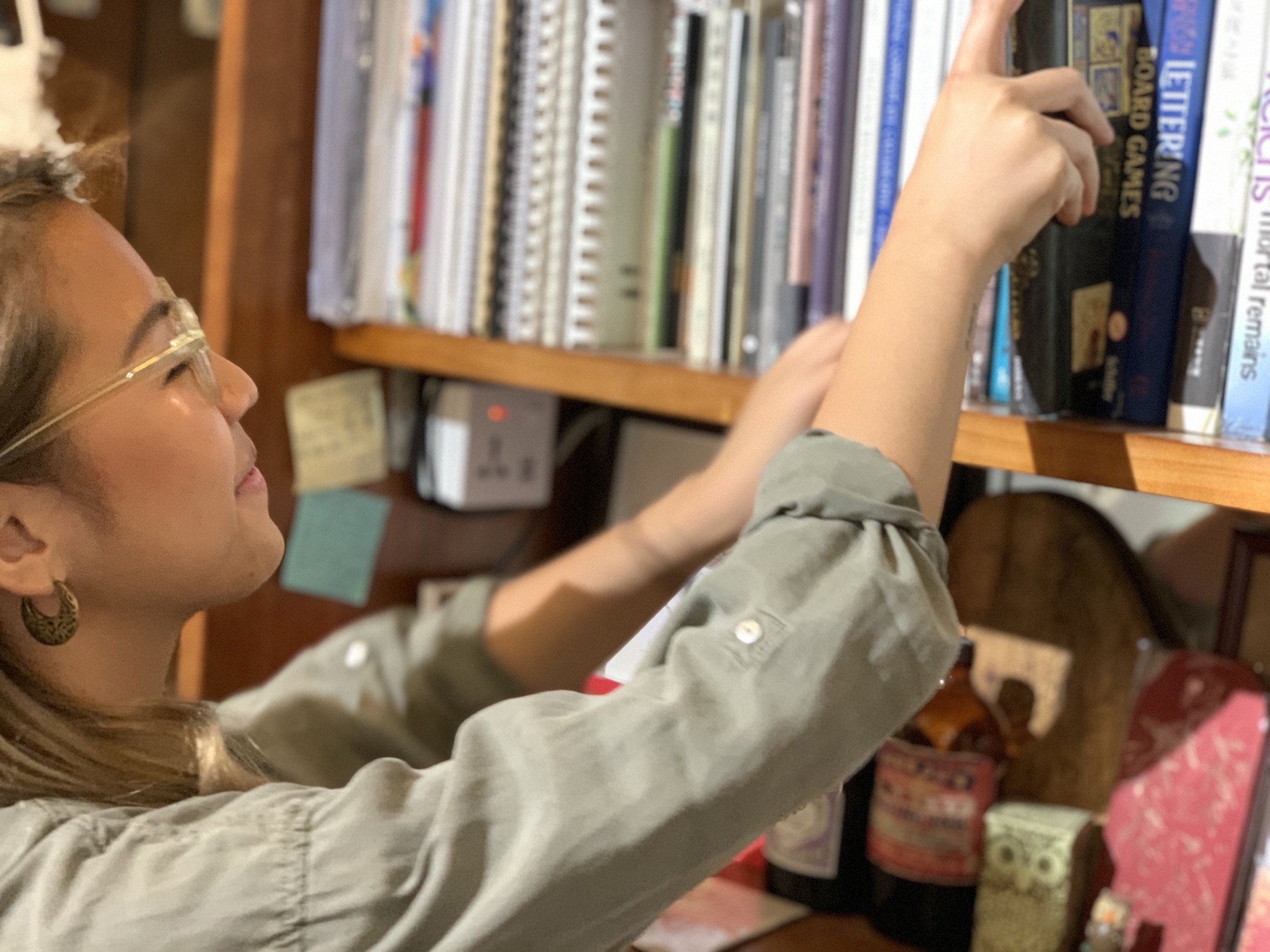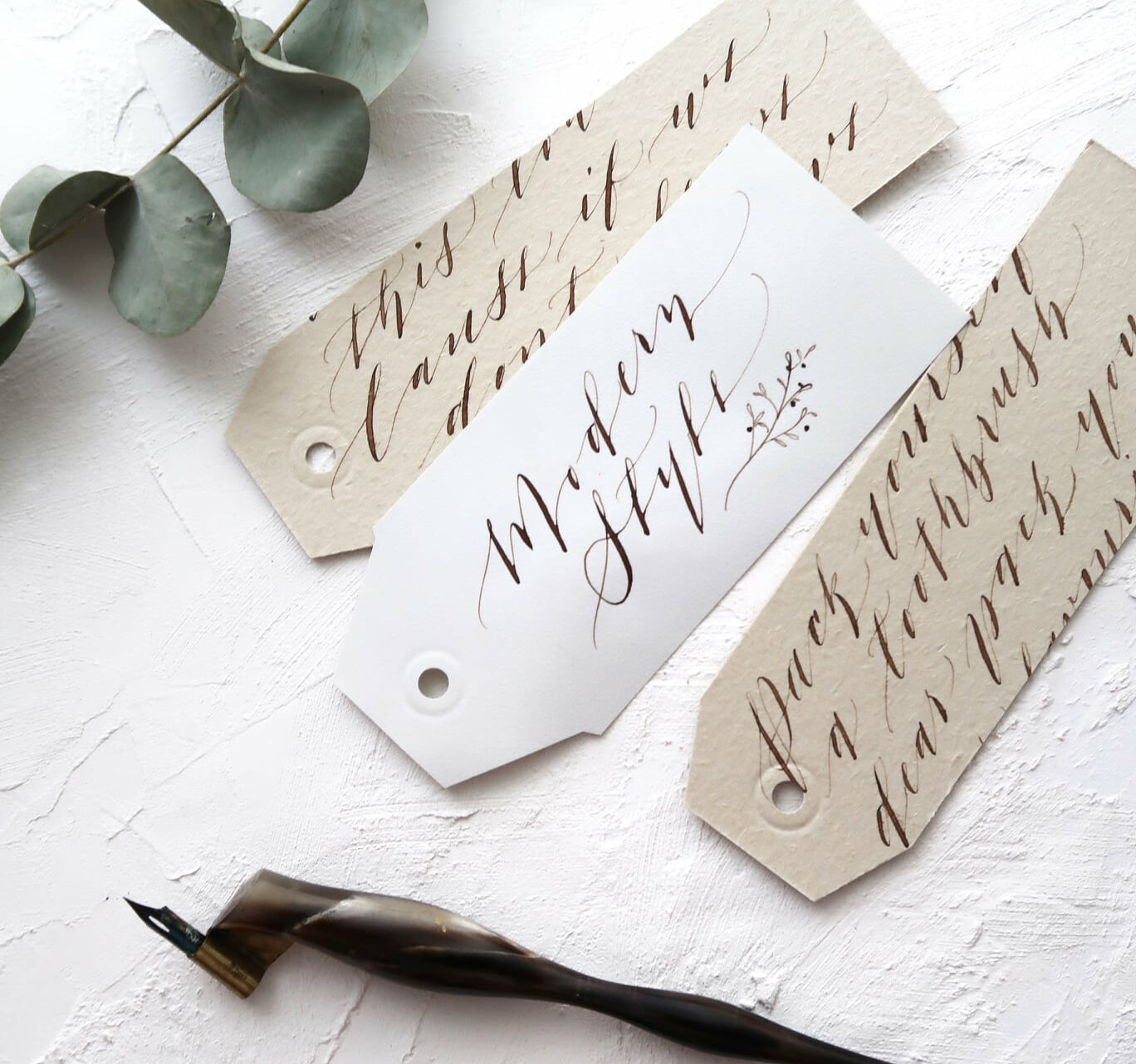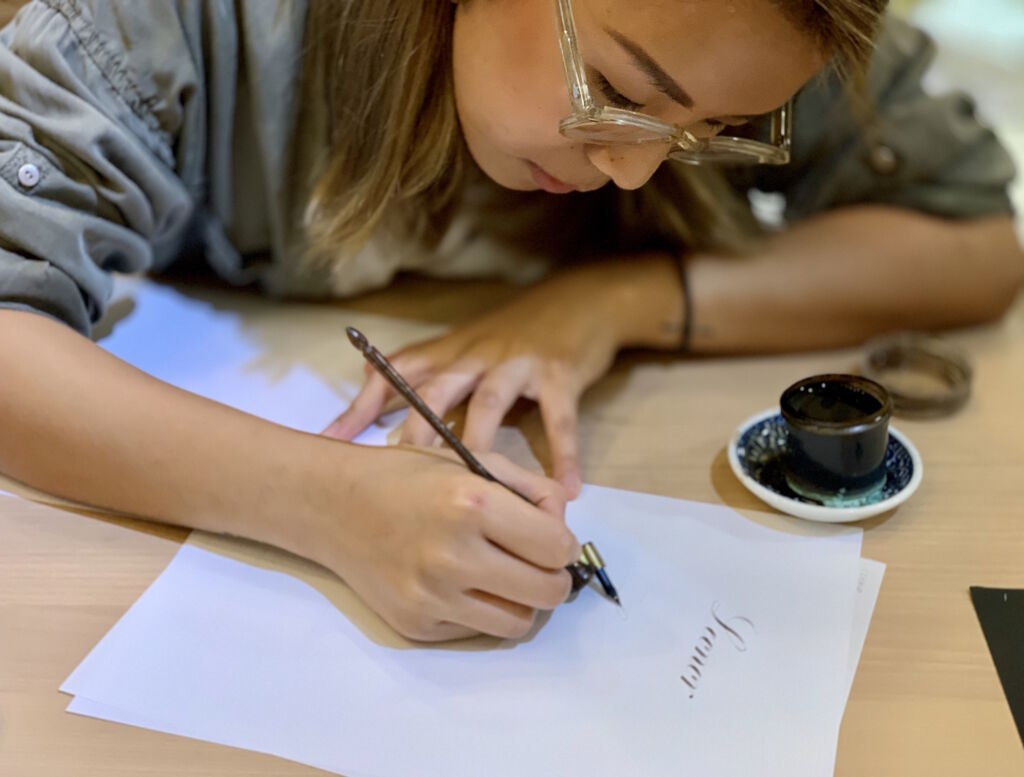Belinda Chim was born and raised in Macau, but soon found her way to Australia, where she graduated. It was there that she found her passion for calligraphy, an ancient way of writing, considered by some as art. Belinda then returned to Macau and has been dedicating her time to teaching the numerous types of calligraphy to people looking to relax or learn this craft. She’s also been perfecting her own and this is done with daily training, as well as workshops and reading–lots of it. We sat down with Belinda at her home and studio–where she teaches–and got to know a bit more about this artistry that has much more to it than meets the eye.
First of all, can you explain what calligraphy is?
Essentially, it’s just a word that means “beautiful handwriting”. It can be anything that you do with a dip pen but also normal handwriting. There’s something else called hand lettering; it’s something where you involve pictures and illustrations with letters as well. It’s when people are more creative in terms of using markers, kind of employing design in lettering. There’s also a different area called penmanship: so basically most people can do calligraphy, but just a few can master penmanship. It’s a style where you dissect the letters in terms of axes and angles, curling, and more.
So would it be correct to say penmanship is the science within calligraphy?
Yes, one could say that.
What do you consider yourself?
Presently, I see myself as a calligrapher, but hopefully, I can later be able to become a penman. I think that in Macau and Hong Kong, most call themselves calligraphers, but in the UK and the USA, some consider themselves penmen. They have more knowledge when it comes to history, like who created this or that style, who created a certain penholder, the different eras. For me, a penman has to be really good in history and are really good; they know how to explain specific things.
In what way could a penman’s abilities be useful?
What these professionals usually do for a living is teach as this is a dying craft and they want to promote it. Both calligraphy and penmanship.

What about you?
I like teaching and I want to promote calligraphy. I teach as a means of income. In the future, my top priority is to keep doing calligraphy, maybe even create some products based on it, as well as advocate for animal rights. This is my priority.
I’m a vegan and I also like to promote veganism as a way of living. At the end of the day, I like promoting calligraphy, but it’s not such a relevant priority for me as it is for master penmen, for example.
I teach calligraphy mainly to help people–some of my students are sad, have personal problems, are stressed out. People nowadays have stressful jobs and they just want to come here and distress. However, I also want to use calligraphy to make my own way; and that involves promoting veganism as well. I’m about to do a calendar for 2021 with themes related to animal rights and vegan issues. I write and practice vegan-related quotes with different calligraphy styles.
Are master penmen rare?
Yes, there are just 16 or 17 in the whole world; I had classes with two of them, who gave workshops in Hong Kong and I took it. They go through a list of tests and exams and end up doing their own diplomas. They’re usually old and their life goal is to promote penmanship and calligraphy.
If someone wants to learn calligraphy from you, how does it happen?
I provide one-on-one or two student classes. We also have government subsidies nowadays, so I can teach even bigger classes, but I prefer having a smaller number of students. I don’t have the space to do such big classes and they can’t see everything at the same time, like the sheets and examples I write down.
Where and what do you teach in those classes?
First, I sent prospective students a PDF file with lots of styles and some important info on the matter, because I offer different script classes; in the first class, I’ll teach on styles and materials, and first strokes so they can start training.
How can people reach you?
By sending me a message on Facebook or Instagram.
How did this passion start?
I have loved words and letters from a young age. When I bought products such as notebooks, I would choose the type of letters used and would be very anal about it. When I went to Australia to study graphic design–which I studied for a year within a really intense program–we had a typography class. In those classes, we learned about the history behind this and calligraphy was part of it. People can convert calligraphy into letters, basically. I was amazed by it and the teacher is good which was also really helpful.
They gave us really good materials and resources; a really good thing about this school was that they gave us lots of resources like names and backgrounds so we could learn about what we wanted to do. Calligraphy was included so I got really interested in this area but finding the necessary materials was hard, even in Australia. Back then–six years ago–it was hard to find good penholders and pen nibs. Now it’s better, they’ve got a whole store dedicated to calligraphy!
First, I started with basic doodling and went a bit on and off on this. At the time, I was paying an international fee and living there with some classmates from Macau. After graduating from graphic design, I kept living there but had nothing much to do and didn’t like design that much. That’s when I decided to start a criminology degree–for three years. At the time, I had to dedicate my time to study and kept doing calligraphy as a hobby. When I finished, I decided to come back to Macau and started figuring out what I wanted to do; I was fortunate enough to have people who helped me along the way.

How did you start teaching in Macau?
I was lucky enough to return, in 2017, when those government subsidies for local residents to invest in their education were still running, so I applied to become a calligraphy teacher.
How does calligraphy translate into your life? Is it just as a job?
No, it’s everywhere in my life. It’s become my job and sometimes I teach for the whole day. I also use calligraphy to relax and ease my mind.
What else are you thinking or doing that involves calligraphy?
Making some products related to it, like posters and calendars to sustain myself and create a brand of my own. In the end, I want to promote this craft and knowledge, but also to promote my name and my brand, as well as use calligraphy to do something meaningful, like advocating for animal rights. These would all be animal-themed.
I have Mondays off when I brainstorm new ideas; it’s de-stressing as well.
You also like doing wedding and holiday stationery. Can you tell us what these are?
Those aren’t something I do in a series, rather it’s just something I do for people who want different wedding vows, for example. They’ll give me paper or I’ll source it and I’ll write their wedding vows in a special calligraphy style. I’ll also create a wedding logo.
I also do calligraphy with animals, including doves, swallows, and so on; in Chinese culture, these mean purity. I can also use a pen to create flowers or paintings.
Would you call yourself an artist?
Not really. I see myself as more of a calligrapher who can also do artistic work when it comes to calligraphy.
Can you tell us where calligraphy can be used in our daily lives?
Every occasion, with cursive (a calligraphy style). I used to tell people, “This is more on the artistic side, but not so practical. It’s more decorative.”
What do people look for when they come to have a calligraphy class with you?
I have two types of students: some come to de-stress and relax, others attend classes because they need it for their jobs. Examples of the latter are pastry chefs and some CEOs from companies who want to learn cursive so they can improve their handwriting.
So you recommend these classes for people who want to de-stress?
Yes. I won’t press them to do anything special, just let them take their time to relax.
In what language do you teach?
Mostly Cantonese, but I also have some students that prefer English, so both.
So you have both Chinese and foreign students?
Yes, both. Few foreigners, though because I think people don’t really know where they can learn. I think nowadays people find me on a word of mouth basis.

Are there different calligraphy styles?
Yes, they’re called scripts. There’s Engrosser’s, Cursive, Modern, and more. All of them have different ways of writing, angles, spaces, and other elements.
What about Chinese calligraphy. Do you also specialize in it?
I tried it and like it! I studied in an English school–Santa Rosa de Lima–and that’s why my written and handwritten Chinese is kind of bad (laughs). I’m interested in learning Chinese calligraphy but I know it’s going to be very hard because there are many strokes and there’s a heap of other spectrums.
What about your hobbies?
Calligraphy (laughs)! When I want to relax, I just do the basic strokes for an hour or so. My whole life is calligraphy. I’m vegan and also love to eat and finding new places to go to.
What’re your favorite restaurants?
Puffin Café and Round-the-Clock in Grand Lisboa have a whole vegan menu.
Do you cook as well?
Not really, because I’m very busy. I usually just make a smoothie in the morning, then just grab a takeaway from somewhere.
When you have friends visiting the city, where do you take them?
Those little narrow streets with shops and new cafés, behind the Ruins of St. Paul’s, but also the ruins itself. Then maybe Puffin Café to grab some food. Also Taipa and Taipa Village and eventually try some food at The Blissful Carrot. The green houses–Taipa Houses-Museum is also a cool place to visit. I wouldn’t take them to casinos because they can see those back home or in other countries, they wouldn’t be interested in that.
Also read: The Best Things to Do in Taipa Village
If you’re looking for calligraphy classes with Belinda or more on this craft, check her Facebook page or follow her on Instagram @belindachim



































